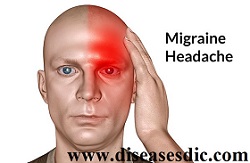Description
A migraine is a neurological condition that causes a severe or a moderate headache on one side of the head with throbbing pain. This headache may radiate towards the forehead or temple, eyes and makes a person to develop nausea, vomiting, vision problems, and sensitivity to normal light or mild exertion.
People describe migraine pain as:
- Pulsating
- Throbbing
- Perforating
- Pounding
- Debilitating
“Classic” migraines begin with an aura such as seeing visual field changes (dots, wavy lines, blurriness) about an hour or less before the pain begins.
Pathophysiology
A migraine is a brain disorder that involves an altered regulation and control of afferents, with a particular focus on the cranium. The once-popular vascular theory of a migraine, which suggested that a migraine headache was caused by the dilatation of blood vessels, while the aura of migraine resulted from vasoconstriction, is no longer considered viable. Vasodilatation, if it occurs at all during spontaneous migraine attacks, is probably an epiphenomenon resulting from instability in the central neurovascular control mechanism.
Types of a migraine
- A migraine with aura – where there are specific warning signs just before a migraine begins, such as seeing flashing lights.
- A migraine without aura – It is the most common type, where a migraine occurs without the specific warning signs.
- Migraine aura without a headache, also known as a silent migraine – where an aura or other migraine symptoms are experienced, but a headache doesn’t develop.
Causes
The exact causes of a migraine are still unknown.
- Migraines may be caused by changes in the brainstem and its interactions with the trigeminal nerve, a major pain pathway.
- Imbalances in brain chemicals such as serotonin regulate pain in the nervous system. But still, research is going on to study the actual role of serotonin during migraines.
- Generally, serotonin levels drop during migraine attacks. This may cause your trigeminal nerve to release substances called neuropeptides, which travel to your brain’s outer covering (meninges). The result is migraine pain. Other neurotransmitters play a role in the pain of a migraine, including calcitonin gene-related peptide (CGRP).
Risk factors
- Changes in the weather
- Changes in your daily schedule
- Skipping a meal
- Change in your sleeping pattern
- Strong light
- Smells which stimulate
- Strong noises
- Menstruation
- Ovulation
- Pill-free days if you take the pill.
Risk factors of a migraine from food
- Wine
- Chianti
- Derivatives of red wine
- Champagne
- Sherry
- Beer and white wine
Symptoms
- Eye pain
- Sensitivity to light or sound
- Nausea
- Vomiting
- Severe pain
- Food cravings
- Depression
- Fatigue or low energy
- Frequent yawning
- Hyperactivity
- Irritability
- Neck stiffness
Complications
- Extensive deterioration in the quality of life.
- Significant disability, affecting home life, work, and social activities.
Diagnosis and Test
Doctors diagnose migraines by listening to your symptoms, taking a thorough medical and family history, and performing a physical exam to rule out other potential causes. Imaging scans, such as a CT scan or MRI, can rule out other causes, including:
- Tumors
- Abnormal brain structures
- Stroke
Treatment and medication
Migraines can’t be cured, but your doctor can help you manage them. Your treatment plan depends on your age, frequency of a migraine, type, and symptoms. The treatment pattern includes the combination of the following steps:
- Self-care migraine remedies
- Lifestyle adjustments, including stress management and avoiding migraine triggers.
- OTC pain or migraine medications, such as NSAIDs or acetaminophen (Tylenol)
- Painkillers – including over-the-counter medications such as paracetamol and ibuprofen
- Triptans – medications that can help reverse the changes in the brain that may cause migraines
- Anti-emetics – medications often used to reduce nausea and vomiting
- Counseling
- Alternative care, which may include biofeedback, meditation, acupressure, or acupuncture
Prevention
- Sleep Smart: Sleep is a critical trigger. Too long or too little sleep can bring on a migraine. Therefore it is much important to have your sleep time constant.
- Do not skip your meals. When your blood sugar level drops brain is the first organ that feels it. Hunger is the common cause of headaches.
- Be conscious of your caffeine level.
- Sometimes drastic exercise activity can spark a migraine. Following moderate activity will give your overall health a boost and help you stay headache-free.
- Even dehydration can cause a migraine and so it is a must to drink too much water when you are roaming under the sunlight.
- Hours in front of a computer or TV can strain your eyes. Eyestrain leads to head pain. Take breaks often. Stretch, close your eyes, and get up to get your blood flowing.
- Sometimes tooth pain can also trigger a migraine thus it is advised to take care of your teeth health.

